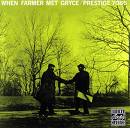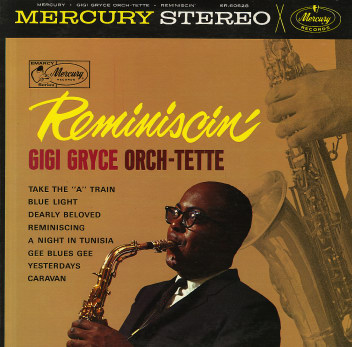Blue Lights – Gigi Gryce
A great minor blues head with a clever introduction and interludes sending off each soloist. Gigi recorded it three times with different arrangements; our "Gigi Gryce Project " version (with Minus You tracks for all instruments) is based on the third one (from the album "Reminiscin'").
- Recording: Art Farmer - When Farmer Met Gryce
- Recorded on: May 26, 1955
- Label: Prestige (PRLP 7085)
- Concert Key: F minor
- Vocal Range: , to
- Style: Swing (medium)
- Trumpet - Art Farmer
- Alto Sax - Gigi Gryce
- Piano - Freddie Redd
- Bass - Addison Farmer
- Drums - Art Taylor
- Description
- Historical Notes
- Solos
- Piano Corner
- Bass Corner
- Drum Corner
- Guitar Corner
- Inside & Beyond
- Minus You
This Gigi Gryce composition has been recorded quite a few times, including three times by Gigi. Our lead sheet is taken from the first recording. Gigi also recorded it on August 9, 1957, with the Donald Byrd-Gigi Gryce Jazz Lab, and on November 9, 1960 (Gigi Gryce, "Reminiscin'," for Mercury). Gigi was a great arranger and always made new arrangements when re-recording one of his compositions, so they're all worth a listen. Other artists who also recorded Blue Lights include: Coleman Hawkins on his"When The Hawk Flies High
Learn more about Gigi Gryce at Noal Cohen's Jazz History website. Also see Gryce's discography.
Related Songs
Email Send Blue Lights to a friend
- Recording: Gigi Gryce - Jazz Lab
- Recorded on: August 9, 1957
- Label: Jubilee (JLP 1059)
- Concert Key: F minor, No key center
- Vocal Range: , to
- Style: Swing (medium)
- Trumpet - Donald Byrd
- Alto Sax - Gigi Gryce
- Piano - Hank Jones
- Bass - Paul Chambers
- Drums - Art Taylor
Video
- Description
- Historical Notes
- Solos
- Piano Corner
- Bass Corner
- Drum Corner
- Guitar Corner
- Inside & Beyond
- Minus You
A Concert Condensed Score is available for this version; see The Gigi Gryce Project album cover for lead sheets and second parts.
This is the only one of Gryce's compositions that he recorded in quintet settings with three different trumpeters: first Art Farmer, then Donald Byrd, and lastly with Richard Williams.
For more information on Gryce and his activities, check out Noal Cohen's Gryce discography and book.
Related Songs
Email Send Blue Lights to a friend
- Recording: Gigi Gryce - Reminiscin'
- Recorded on: November 9, 1960
- Label: Mercury (MG 20628)
- Concert Key: F minor
- Vocal Range: , to
- Style: Swing (medium up)
- Trumpet - Richard Williams
- Alto Sax - Gigi Gryce
- Piano - Richard Wyands
- Bass - Julian Euell
- Drums - Walter Perkins
Video
- Description
- Historical Notes
- Solos
- Piano Corner
- Bass Corner
- Drum Corner
- Guitar Corner
- Inside & Beyond
- Minus You
As with the "Jazz Lab" version, the interlude is used to send off solos after the first solo; the first and third measures are harmonized and again have the fourth beat short. There is a new shout chorus added, a funky riff that is played once in unison and a second time in octaves. The ending presents a compromise between the other two versions, with the rhythm section first hitting F minor and then a D♭ chord—but here it is a C triad over D♭ rather than an E♭ triad.
The Concert Condensed Score is available for this version; see the last album cover ("The Gigi Gryce Project") for all lead sheets and second parts, as well as Minus You audio tracks.
Related Songs
Email Send Blue Lights to a friend
- Recording: Gigi Gryce - The Gigi Gryce Project
- Recorded on: September 2, 1999
- Label: jazzleadsheets.com (JLS 1024)
- Concert Key: F minor
- Vocal Range: , to
- Style: Swing (uptempo)
- Alto Sax - Bobby Porcelli
- Tenor Sax - Ralph Moore
- Piano - Richard Wyands
- Bass - Peter Washington
- Drums - Kenny Washington
Video
- Description
- Historical Notes
- Solos
- Piano Corner
- Bass Corner
- Drum Corner
- Guitar Corner
- Inside & Beyond
- Minus You
The interlude and shout chorus are the same as in the "Reminiscin'" version. The first chorus of the out head has the tenor answering the alto melody, in the same way that the piano answers the unison horns on the in head. The piano has a different rhythmic comping figure during this chorus. The coda is again the same as that of the "Reminiscin'" arrangement.
Note that all lead sheets and second parts are available, as well as Minus You audio tracks (click the Minus You tab).
Reminiscin' on "Reminiscin'"! Though the horn arrangement is different, pianist Richard Wyands on this recording is playing almost entirely the same part he played 39 years before on the "Reminiscin'" album. For an even more authentic experience for yourself, the "Reminiscin'" horn arrangement can be used by two players with our minus melody performance or practice tracks.
On our Condensed Score, lead sheets and parts, the interlude played between the soloists is labeled [1] and the shout chorus [2]. The interlude is the first four measures of a chorus; [1] is considered to include soloing for the rest of the chorus.
Also, note that the D.S. for the return to the out melody is in either of two different places depending on the part. The tenor and piano parts are different on the first chorus of the out head from the in head. The melody and bass line are the same. In the score, the second horn parts and the piano part, the D.S. is after eight measures of the out melody A3; the lead sheets, first horn parts and bass and drum parts all have the D.S. at the beginning of the melody.
mp3 Form of the quintet track:
-- intro
-- head 2 choruses
-- piano solo 4 choruses
-- [1] to tenor sax solo - continues for 3 more choruses
-- [1] to alto sax solo - continues for 3 more choruses
-- [1] to bass solo - continues for 2 more choruses
-- [2] shout chorus 2 times
-- out melody A3 (take the D.S. after 8 measures)
-- out melody A2
-- coda
mp3 minus melody—piano comping has been added to the first 4 solo choruses, which were originally a piano solo
-- count off sets up the intro
-- play the intro
-- play the melody 2 times
-- solo
performance edition: solo 4 choruses, play [1], solo 3 more choruses
practice edition: solo 4 choruses, play [1], solo 3 more choruses, play [1], solo 3 more choruses
-- play the shout chorus 2 times
-- play the out melody 2 times and coda
mp3 minus Piano
-- count off sets up the intro
-- play the intro and melody as written
-- solo 4 choruses
-- comp for [1] and tenor solo 3 more choruses, [1] and alto solo 3 more choruses, [1] and bass solo 2 more choruses
-- comp for the shout chorus 2 times
-- play figures for out melody A3 (take D.S.)
-- play as written for out melody A2 and coda
mp3 minus Bass
-- count off sets up the intro
-- play the intro and melody 2 times as written
-- walk for the piano solo 4 choruses
-- play [1] and continue walking for the tenor solo 3 more choruses, [1] and alto solo 3 more choruses
-- play [1] and solo, continue for 2 more choruses
-- walk for the shout chorus 2 times
-- play the out melody 2 times and coda as written
mp3 minus Drums—sticks throughout
-- count off sets up the intro
-- play figures for the intro
-- comp/play figures for the melody 2 times
-- comp for the piano solo 4 choruses
-- play [1] and continue comping for the tenor solo 3 more choruses, [1] and alto solo 3 more choruses, [1] and bass solo 2 more choruses
-- comp for the shout chorus 2 times
-- comp/play figures for the out melody 2 times and coda
mp3 Bass and Drums only - to feature piano, guitar, vibes, or any melodic instrument that likes to play without harmonic accompaniment
-- count off sets up the intro
-- play the intro and melody 2 times as written
-- solo 4 choruses
-- play the shout chorus 2 times
-- play the out melody 2 times and coda as written
Related Songs
Email Send Blue Lights to a friend

Gigi Gryce
November 28, 1925 – March 17, 1983
Gigi Gryce was a fine altoist in the 1950s, but it was his writing skills, both composing and arranging (including composing the standard Minority) that were considered most notable. After growing up in Hartford, CT, and studying at the Boston Conservatory and in Paris, Gryce worked in New York with Max Roach, Tadd Dameron, and Clifford Brown. He toured Europe in 1953 with Lionel Hampton and led several sessions in France on that trip. Read more...






